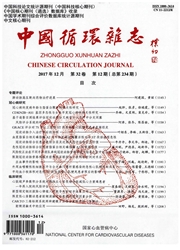

 中文摘要:
中文摘要:
目的:探讨急性右心室梗死(ARVI)临床和血流动力学特征以及扩容与再灌注治疗效果。 方法:观察58例ARVI患者的临床经过,根据有创血流动力学特征分为1型(n=28)、2型(n=19)、3型(n=11)共三型,根据是否行再灌注治疗分为一般治疗组(n=29)及再灌注治疗组(n=29),评估扩容及再灌注治疗的疗效。以发病2周及4周的存活率或病死率和心脏超声右心室运动评分为观察指标。 结果:血流动力学1、2、3三型的病死率分别为:3.5%,26%,54%,其中2型多为严重ARVI,常常伴严重低血压休克,预后较差;3型除ARVI外,左心室梗死程度重,治疗效果差。1、2型患者对扩容效果好。所有患者在再灌注治疗组存活86%,右心室超声评分改善1.2;一般治疗组存活72%,右心室超声评分改善0.4,两组比较差异显著(P〈0.05)。 结论:ARVI血流动力学特征检测有助于病情评估和治疗选择。再灌注治疗可明显提高患者心肌功能的恢复,降低病死率。
 英文摘要:
英文摘要:
Objective: To investigate the hemodynamic characteristics of acute right ventricular infarction and to determine whether the volume-expansion and reperfusion administration improve the clinical outcomes and survival after acute right ventricular infarction. Methods: We observed the clinical outcomes of 58 patients with acute right ventricular infarction. According to the hemodynamic characteristics, the patients were divided into three types ; and according to treatment strategy, the patients were divided into common treatment group and reperfusion treatment group. The effects of volume-expansion and reperfusion administration were analyzed on survival or mortality at 2 and 4 weeks after the attack. The right ventricular function was studied by echocardiography. Results: The mortality of each type was 3.5% ,26% or 54%, respectively. Most patients in type 2 had severe right ventricular infarction and severe hypotension shock ; while in type 3, the patients with severely damaged right and left ventricular function had a higher mortality rate. In patients on reperfusion treatment, the survival was 86% at the end of the 2^nd week, and the right ventricular function score was improved by 1.2. In patients on common treatment, the survival was 72% and the right ventricular function score was improved by 0.4, both having significant differences. Conclusion: The detection of hemodynamic characteristics is helpful for the evaluation and treatment strategy in patients with right ventricular infarction. Reperfusion treatment can improve right ventricular function and decrease mortality.
 同期刊论文项目
同期刊论文项目
 同项目期刊论文
同项目期刊论文
 期刊信息
期刊信息
